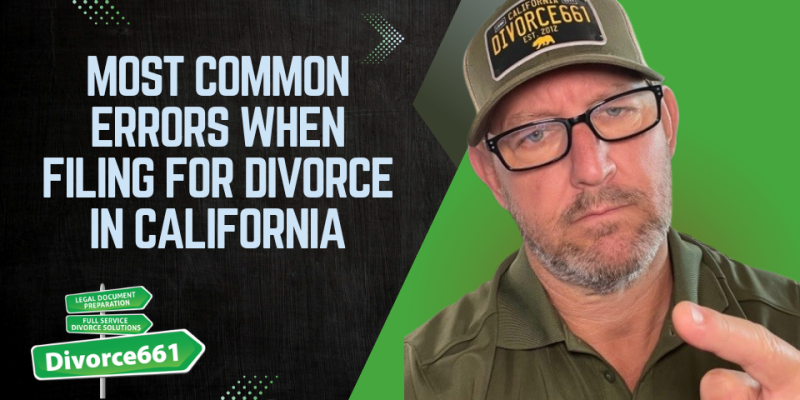What to Do If Your Divorce Papers Are Rejected in Alameda County
I’m Tim Blankenship of Divorce661. If the Alameda County court rejected your divorce paperwork, you’re not alone — Alameda has some of the strictest e-filing rules in California. In this article I’ll explain the most common reasons filings get rejected, walk through a real client example, and give you a practical checklist to get your case accepted the first time.
Why Alameda County rejects divorce filings
Alameda County requires all divorce forms to be submitted electronically, and the court applies tight quality-control standards. That means even small omissions — a missing attachment, an unchecked box, or an incorrect date — can cause a rejection. Rejected filings delay your case and create unnecessary stress, but most rejections are fixable if you know what to look for.
Common mistakes that lead to rejection
- Missing attachments: Required exhibits, disclosures, or supporting documents not uploaded with the filing.
- Incomplete forms: Items left blank, sections not filled out completely, or forms marked incorrectly.
- Blank checkboxes: A single unchecked box can flag a form as incomplete.
- Incorrect dates: Inconsistent or incorrect dates on forms that create confusion for court clerks.
- Missing disclosures: Financial disclosures and other mandatory statements that weren’t included or were improperly completed.
- E-filing errors: Problems during the electronic submission process — wrong file types, uploads that didn’t attach, or system validation failures.
- Confusing court notes like “FL-180 incomplete”: The court’s notation simply means the particular form (FL-180 or similar) was missing required information.
Understanding “FL-180 incomplete” and other court notations
Court notations like “FL-180 incomplete” can seem cryptic. FL-180 is a court form (a judgment-related form in California family law), and a note that it’s “incomplete” means required fields or attachments are missing. When you see this, don’t panic — treat it as a checklist: identify the missing items, correct the form, and resubmit via e-filing.
Real client example: three rejections, approved in a week
One client came to us after their judgment was rejected three times. The problems were straightforward but easy to miss: missing disclosures, incorrect dates, and overlooked checkboxes. We performed a full review, corrected the errors, and resubmitted the corrected filing. The court approved the judgment within one week.
“After thorough corrections, their judgment was approved within a week.”
How to avoid rejections — practical checklist
- Use an item-by-item checklist: Before e-filing, run through a checklist of required forms, attachments, and signatures.
- Double-check dates and names: Make sure all dates and party names match across every document.
- Confirm attachments are uploaded: Open each uploaded file to verify it’s the correct document and fully legible.
- Fill every required field: Even if a field seems optional, verify whether the court expects a response (e.g., mark N/A rather than leaving blank).
- Look for checkboxes: Scan each page for unchecked boxes that might be interpreted as incomplete information.
- Save and review PDFs: Generate the final PDF exactly as it will be viewed by the court and review it page-by-page.
- Understand e-filing requirements: Know the file types, naming conventions, and upload limits required by Alameda County’s e-filing system.
- Keep a clean audit trail: Record submission confirmations and clerk comments so you can respond quickly if changes are requested.
How Divorce661 fixes rejected divorce filings
At Divorce661 we specialize in correcting rejected divorce paperwork in Alameda County and across California. Our process focuses on speed and accuracy:
- Full case review: We examine every form and attachment to identify the rejection reasons.
- Precise corrections: We fix missing disclosures, correct dates, check every box, and ensure files are court-ready.
- Resubmission: We refile the case electronically following Alameda County’s requirements so it’s accepted without further delays.
- Flat-fee, remote support: No hourly surprises — we provide clear pricing and remote assistance across California.
“We meticulously review your entire case, identify issues, and resubmit it correctly.”
When to get professional help
If you’ve been rejected more than once, you’re short on time, or you want to avoid the stress of repeated resubmissions, professional help can save time and reduce errors. A specialist will catch the small issues clerks flag and get your case back on track quickly.
Conclusion — don’t let paperwork errors hold you back
Alameda County’s e-filing rules are strict, but most rejections result from small, fixable errors: missing disclosures, unchecked boxes, or incorrect dates. With a careful review and proper resubmission you can avoid delays. If you need help, schedule a free consultation with Divorce661 at divorce661.com — we’ll review your case, correct the issues, and get your filing accepted as quickly and stress-free as possible.










